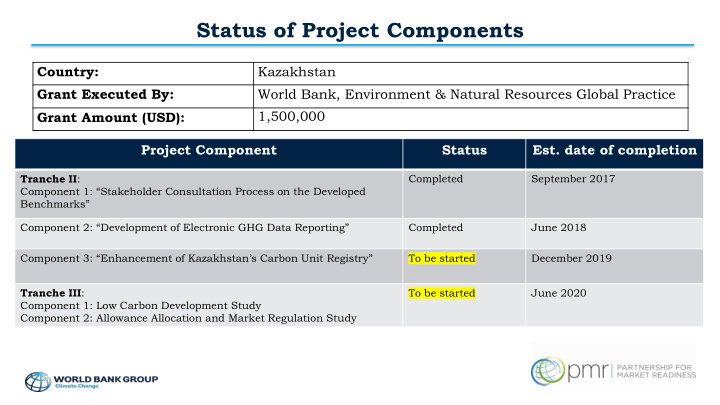



Status of Project Components Country: Kazakhstan Grant Executed By: World Bank, Environment & Natural Resources Global Practice 1,500,000 Grant Amount (USD): Project Component Status Est. date of completion Tranche II : Completed September 2017 Component 1: “Stakeholder Consultation Process on the Developed Benchmarks” Component 2: “Development of Electronic GHG Data Reporting” Completed June 2018 Component 3: “Enhancement of Kazakhstan’s Carbon Unit Registry” To be started December 2019 Tranche III : To be started June 2020 Component 1: Low Carbon Development Study Component 2: Allowance Allocation and Market Regulation Study
Key Achievements since last ISR Key Policy Achievements Kazakh ETS relaunched its operation by adopting the NAP covering the period of three years (2018 – • 2020) (the Government Decree 873 as of December 26, 2017). • The hybrid method was approved by the Government Decree 370 as of June 15, 2017. The allocation was provided per installation, not as per entity as it has been previously The Ministry of Energy (ME) implemented hybrid method of allocation - grandfathering and • benchmarks • The 2018 – 2020 NAP includes totally 225 installations . Allowances were allocated by using benchmarks to 149 installations and by grandfathering method to 76 installations. The final set of 52 benchmarks was approved by the Minister’s Order #222 as of July 28, 2017. The competence for accreditation of validation and verification bodies has been transferred to the • National Accreditation Center under Ministry of Investments and Development. The process of accreditation is conducted according to ISO standards. Development of Electronic GHG Data Reporting: the software system is fully operational . It has IT security certification. All the users, emitters, verifiers and the Committee on State Regulation and Control, are engaged in the processes of the system. An online help desk is also accessible for system users.
Key Challenges Going Forward Review of existing national legislation related to GHG regulation and develop updated versions of • Chapters for a new Environmental Code; Initiate activities for developing a Roadmap for NDC implementation; • Organize discussions on vision of Kazakh ETS beyond 2020 with key stakeholders; • Restart components under the Tranche II and launch activities for developing ToRs under Tranche • III; Information of a potential reorganization of two institutions under the ME RK: “Informational and • Analytical Centre”, RSE and “ Zhasyl damu ”, JSC, as well as optimization process in the ME RK must not create barriers for implementation of components under the PMR tranches. • Develop legal documents for coordinating work between Validation/Verification companies and ME RK.
Key Lessons Learned • Implementation of tasks and activities depends on the capacity and knowledge of all key stakeholders at different national levels. • Engagement of international partners (DIWecon Co, CITEPA, etc.) in research studies and consultations is useful for raising capacity of national stakeholders. Good practice was obtained when developing benchmarks and INDC process under the • component Development of Policy Options for Mid- and Long-term Emissions Pathways and Role of Carbon Pricing. • Strong support of the PMR WBG team to the CCD staff was very valuable and useful.
Recommend
More recommend